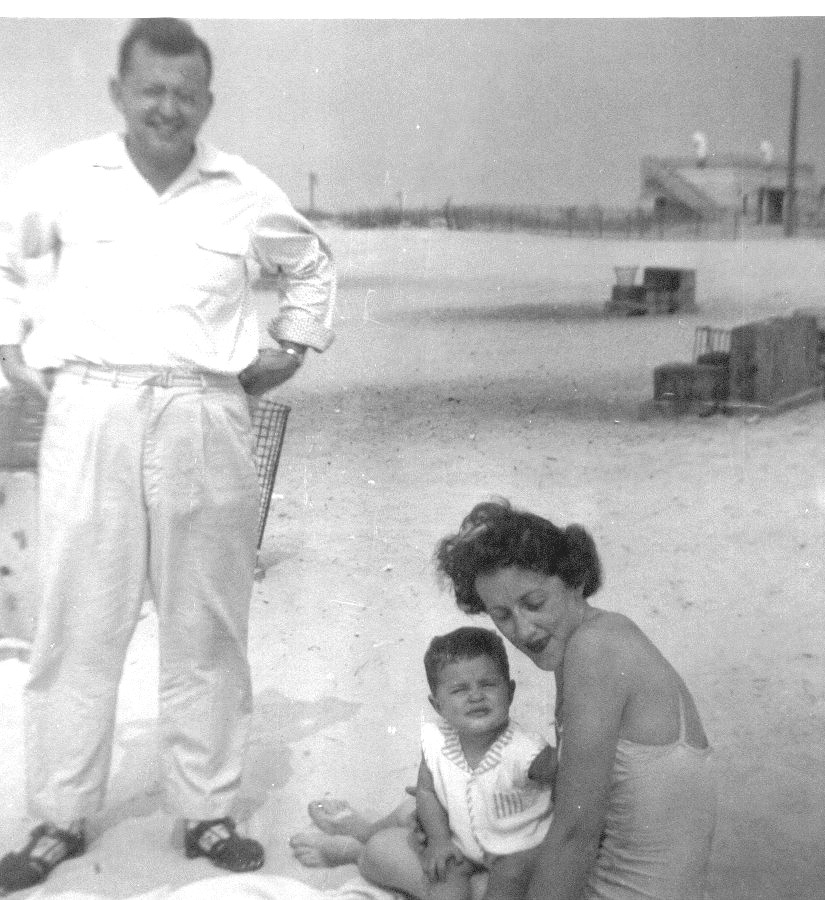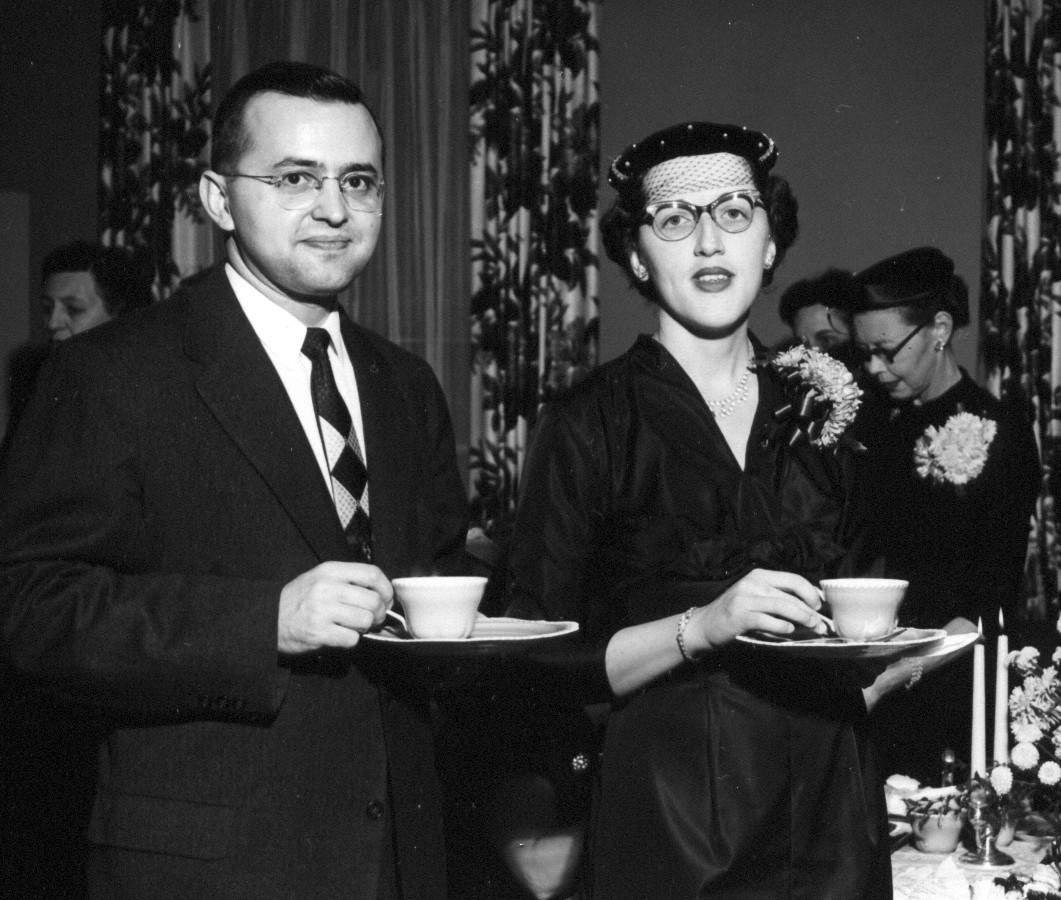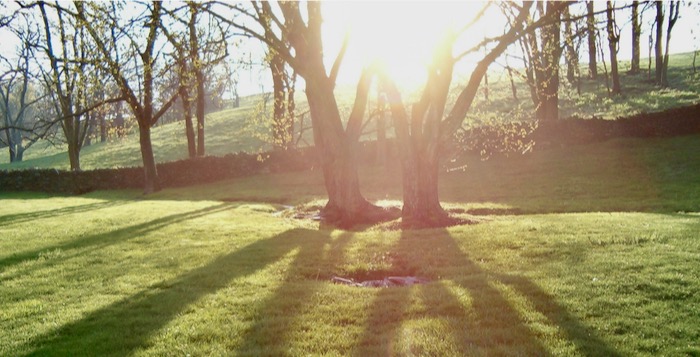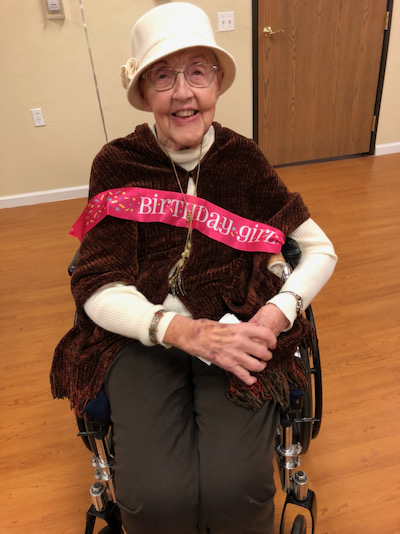.
Do not wait until some deed of greatness you may do,
Do not wait to shed your light afar,
To the many duties ever near you now be true,
Brighten the corner where you are.
.
By DAVID CRUMM
Editor of ReadTheSpirit magazine
My mother lived for 95 years through all manner of challenges—from the Great Depression to life-threatening illnesses. In her final year, she had such excellent care that she survived the COVID pandemic, despite needing frequent visits by caregivers in her apartment in Grand Blanc, Michigan. Although she had been receiving hospice care for a month for a variety of illnesses, she still was hoping to greet 2021 and perhaps celebrate her 96th birthday in February. At the very least, she expected to make it to Christmas.
All of us were shocked that she simply and peacefully slipped away on the morning of December 1, which isn’t technically the start of the Christian Advent season—but, in effect, is the first day because all of our family Advent calendars start with December 1. For Christians, Advent is a season in which all of us bring out our holiday lights and do our best to summon bright hopes in the darkest season of the year. In preparation, on November 30, I had laid out the elaborate, lighted, miniature Christmas village that has graced the mantle over our fireplace for many years in December. On another long surface in our living room, I arranged the many Advent calendars we had collected to mark this month. With all of that preparation, on December 1, we were ready to open the first December 1 doors in those calendars.
I know that many families like to open the little doors on Advent calendars at night, perhaps around dinner time—but, we always open them at dawn. In our home, the first rays of sunshine each day angle through the front windows to warmly illuminate our display.

Summer 1956: Mom and Dad with me at Jones Beach, along New York’s Long Island, not far from where Dad served a parish while in seminary.
That custom was encouraged by Mom. She hated dark and gloomy afternoons. Part of her legacy is a family history of depression, which was so severe when she was a young mother of 35 in 1960 that she had to be hospitalized. I was just 5 years old and had no clue at the trauma that ensued. Suddenly, Mom was gone! And so was my little brother Stephen, who vanished as relatives in another city decided it was impossible for my father to care for two small children while Mom was hospitalized. My brother was gone for months.
That trauma—Mom gone with a mysterious unspoken illness and my own shuttling between daytime caregivers for months on end—was especially scarring because we were a clergy family. Dad served a prominent church in northwest Detroit. Mom’s descent into that severe level of depression—and then hospitalization—wasn’t what a pastor’s family should experience, especially 60 years ago when mental health carried far more mythic baggage than it does today.
What do I recall of that dark and mysterious year of disappearing loved ones? I remember that I began to carefully place my collection of stuffed teddy bears around the perimeter of my bed before I felt safe enough to fall asleep. I drifted off in a circle of bears, each night.
And what was Mom’s response to this new night-time obsession she discovered when she finally did return home? She didn’t try to disturb my elaborate circle of bears. Instead, she invited me to begin spinning stories of a fantastic world called Bearland. I had no idea that she was still struggling to recover from a condition that was invisible to me. What I knew was that my entries into Bearland—as narrated by Mom—always began with my journey by bus “into the deep, deep woods” until finally I would spot the first lights of Bearland—and the bears would emerge to greet me. From there, we had wild and suspenseful adventures in fantastical realms. After hundreds of Bearland stories with Mom in the 1960s, I went on to spin thousands—one each night—in the late 1980s and early 1990s when my own children were young.
What Mom taught me in summoning the wondrous realms of Bearland—in the wake of the dark nights of that 1960 year of vanishing loved ones—was that none of us can control what may befall us in life. None of us can avoid calamities. None of us can escape grief and fear.
What we can do is grasp the power of the stories we tell about our adventures. Bearland was far more than a cycle of fairy tales. Bearland was the birth of my vocation as a writer. When I joined with our Publisher John Hile and other colleagues in 2007 to found a publishing house, our simple motto became: “Good media builds healthy communities.”
None of us can avoid the world’s trauma. But—all of us can choose what stories we tell about our lives together, even after loved ones vanish.
And let me be crystal clear about our family’s experience with chronic depression: Mom’s enduring legacy to her four children isn’t the depression itself—no, her real legacy is that she received good medical and psychological treatment and recovered and learned that living with this challenge was just a part of life. Most people contend with some kind of chronic condition in life. This was just one that she had to manage. She knew this condition ran in families and taught us that we should learn the warning signs and know how to respond.
And, that’s where this particular story returns to the theme of light and darkness. One of the warning signs for her each year were the gray dusks that crept ever deeper into the day as our hemisphere whirled toward December. Not surprisingly, I inherited that from her as well. We both knew it; we both dealt with it.
When I arrived to spend an afternoon with Mom recently, her first words were: “Turn on more lights! You can’t see the poetry you’re going to read if we don’t have more light.” She wanted me to read her favorite Robert Frost poems and had the well-worn hardback of his collected works all ready for me to pick up. We set every lamp in her apartment ablaze—even as I read aloud Stopping by Woods.
Light. Darkness. Light. Darkness.

In the late 1950s, a Methodist clergy family’s life was tightly defined by customs such as this bishop’s tea for young pastors and their wives.
Over the years, Mom loved to talk at length about my work as a journalist and publisher, raising global awareness through stories about the world’s colorful diversity of faiths and cultures. She enjoyed my telling her stories of holidays and festivals that I had witnessed in my own travels around the globe. And, she especially liked me to describe the dozens of exotic shrines and holy sites surrounding Jerusalem, where soot from oil lamps has blackened many of the ancient mosaics and icons. Jerusalem is a wonderland of light and darkness. She loved to hear the traditional story of Hanukkah lamps. She also loved my describing Diwali, the Indian festival of light in late autumn when families lay out elaborate displays of flickering flames. Over the years, I even brought her back tiny clay lamps from Jerusalem and Asia that she tucked into corners of her bookshelves.
And so, we fell into a lifelong pattern—trading in a currency of light, darkness, light, darkness.
As a girl, she was born and bred and saturated and sanctified in the language of darkness and light. She was born into an Evangelical Methodist family in Howe, a tiny town in northern Indiana where most families in the 1920s and 1930s were evangelical with a capital “E.” She was a White Ribbon baby from the moment she was born in the family farmhouse in 1925, which meant her mother formally festooned her crib with a white bow as a visible pledge that alcohol would never touch this child’s lips no matter how long she might live! And, although Mom had no personal interest in the Christian Temperance Union by the time she reached college age, she and my father were never drinkers.
When Mom reached her 80s and 90s, as I talked with her about the faith of her youth, she acknowledged that the small-town Indiana version of Christianity was freighted with the traumas of guilt and all the prejudices of white rural life in that era. Throughout her life, she regretted the sometimes overwhelming burdens and biases of that brand of Evangelical fire on herself and on her nieces and nephews.
But let me also be clear about this: She never, ever abandoned her faith that the loving legacy of her own family outweighed any of its flaws.
Light. Darkness. Light. Darkness.
That was a lesson I’ve never forgotten as a journalist. In the midst of trauma, even in the midst of painfully apparent biases and scars, we can rest on a solid faith that light will always shine in the darkness. No person is beyond redemption. Even the most seemingly dark figure we encounter is not without a spark of light. That may sound like high-flown spiritual reflection. Frankly, it’s Journalism 101: Each life is a unique and irreplaceable mix of experiences and values. Our challenge as journalists is to tell the fair, accurate and balanced story.
Our vocation is to be honest about the darkness. And, to lift up the light as well.
A Song That Stretched
So that’s why Mom, in her 80s, taught me a song that stretched all the way back to her family’s Evangelical tap roots: Brighten the Corner Where You Are. In recent years, we’ve laughed about this old song; and we’ve traded sightings of the song both online and in the movies and on TV. The next time the TCM cable channel reruns the 1931 James Cagney and Jean Harlow classic, The Public Enemy, pay attention to the pompous temperance band that marches right through the worst part of Cagney’s gangster’s lair booming out: Brighten the Corner Where You Are.
At first, this old song seemed to be nothing more than nostalgic amusement of century-old Bible thumping. In one family gathering, just to poke fun at each other, family members would spontaneously bellow the opening verse, guaranteed to spark laughter.
Then, I took time as a journalist to research the story behind the song. It’s easy to trace the song back as far as the evangelist Billy Sunday (1862-1935) and his famous musical collaborator Homer Rodeheaver. In fact, when 78 rpm records became all the rage, Brighten the Corner became Rodeheaver’s greatest hit! Both of those evangelical collaborators, Sunday and Rodeheaver, have lengthy Wikipedia biographies. It’s easy to think that the story stops there. Tracing the song’s origin is even foggier because, as the musical rights shifted hands, Rodeheaver eventually owned the song outright.
But he didn’t write it.
Ina Duley Ogdon—who doesn’t have a Wikipedia page—wrote the lyrics in 1913. The music was written by Ina’s friend and collaborator in her music ministry, Charles Gabriel. If you look up all the verses, the song may sound like it’s focused on saving poor sinners’ souls—and it certainly was used in countless tent meetings for exactly that purpose. That’s how Mom first heard it nearly a century ago.
But, that wasn’t the song’s original purpose. In fact, the song is about caregiving and disability. Ogdon was part of a noted family of evangelists. She wrote hymns, toured the sawdust trail of visiting evangelists herself, and spoke at services even though she was a woman in a man’s realm. But in 1912, her father suffered a devastating automobile accident and she had to give up her travels, including an invitation from the prestigious Chautauqua circuit, to become his full-time caregiver. She wrote that song out of pent-up frustration and eventually downright anger at the seemingly unfair trauma life had dealt her father—and herself, by extension. She dearly wanted to be out there on the road as a leader of revivals for thousands, not locked away with an invalid. The song was her coming to terms with the spiritual power of the smallest choices we make each day in whatever tiny corner we may be confined.
Mom came to love the song more and more—and seriously relied on its inspiration—as her own physical body gave way to the point that she could no longer walk and could survive only with the help of caregivers who visited her small apartment around the clock.
A Simple Story of a Hat
In a number of long telephone conversations in recent years, she would discuss with me versions of this question: “What’s left for me to do of any value in this world? What does God want me to do when I can’t seem to do anything?”
Then, we would talk about that old song, because Ogdon was answering those very questions.
Even in the most limited corner of her little home, Mom could be a warm and supportive friend to those around her, especially her own caregivers. And, in Mom’s case, thanks to 2020 technology, she could be loving and supportive to lifelong friends and family she could reach with telephone calls and personal notes. She could live her life as a visible symbol of not only survival, but real thriving.
In her final years, Mom completely lost her hair, a condition that most women would greet with anxiety. Mom celebrated that she could wear a variety of colorful and sometimes quirky hats—most of them with a story connected to the chapeau. Among her favorites was a beautiful white-lace topi or kufi, given to me by the Muslim author Victor Begg who explained, “You do know it’s actually a men’s cap, right?”
“I do,” I said.
For Mom, the hat was a chance for her to tell anyone who asked about the lace cap about Victor and our friendship. Then, this also became an especially welcoming kind of story because the doctor who tirelessly cared for Mom until the very end was a Sudanese-American Muslim. Our entire family now regards Dr. Osama Galal, who would respond to her medical crises at any hour of the day or night, as a living saint—a brilliant light in our midst.
That’s miles and miles from the Evangelical fire of Mom’s childhood and our family’s roots a century ago.
And Then, a Final Ray of Light
That funny old song we once joked about held real wisdom—so much so that my wife Amy and I had a copy of the sheet music nicely matted and framed for her as a gift for Christmas 2019. In our custom of trading in the currency of light and darkness, this would be a perfect beam of light to send her way. Then, as soon as we brought this artful piece home from the framer, I put it somewhere safe in our home until the holiday—and completely lost track of the gift. We searched. We never found it.
So this brings us back to this past week—to the morning of December 1, 2020—when we began our annual ritual of lighting up our home and opening the first doors on our brightly colored Advent calendars. About 8:30 a.m. that morning as we opened the little doors on more than a dozen calendars, my wife declared that we had once again collected far too many calendars! She instructed me to take a half dozen unopened calendars and store them for next year on a shelf in our basement.
In her apartment in Grand Blanc, Michigan, Mom took her last breath. None of us expected it. I wouldn’t receive a call about her passing for a while.
Dutifully following my wife’s instruction, I turned on the basement light and reached up to store the unused calendars, which is when I spotted a flat, brown-paper package I had never noticed on that shelf. Yes, it was the framed sheet music that had been missing for a year! I peeled back the paper wrapping to see the sheet music and read:
Do not wait until some deed of greatness you may do,
Do not wait to shed your light afar,
To the many duties ever near you now be true,
Brighten the corner where you are.
Here for all your talent you may surely find a need,
Here reflect the bright and Morning Star;
Even from your humble hand the Bread of Life may feed,
Brighten the corner where you are.
I laughed out loud! The frame I had lost was found. Now, we had the perfect last Christmas gift for Mom this year. As I went back up into the living room, I kept chuckling at my own forgetfulness for that entire year—and the pleasure that old song had given to me, and to Mom, and to our entire family. What a perfect final present for her.
At 9:30 a.m., the telephone rang.
She was gone.
In our final morning on this earth together, I thought I had found one last gift for her. In fact, I had received the gift myself. Just as she lay dying, I had opened that brown paper wrapping to reveal one final ray of sunlight she had beamed my way.
Of course, I knew what she wanted me to do with that little beam.
She wanted me to give it to you.
And now I have.
.
Care to Read More?
YOU’LL FIND MY MOTHER’s formal obituary at the Sharp Funeral Home website.
MY MOTHER ALSO ACTIVELY RECOMMENDED many of the individual books we produced since our publishing house was founded in 2007. Here are just a few of the books she cared about:
- A Guide for Caregivers by Benjamin Pratt. As I was editing Ben’s guide for caregiving, Mom was curious about each section of the book and gave me tips along the way about themes to emphasize, including music and good humor. There’s still not a better, multi-faceted book to help lighten the stress and spiritual challenges faced by caregivers.
- Friendship and Faith. Mom loved the idea of this book by the interfaith network known as WISDOM women: Real-life stories about women who dared to cross boundaries and who found friendship on the other side. That describes Mom’s vocation in life and she often recommended this book to others.
- This Far by Faith. Mom and Dad both were deeply committed to encouraging ministry and community life in Detroit. Mom was thrilled when Faith Fowler published her memoir about the Cass Community in Detroit—and Mom laughed out loud at the end of Faith’s first chapter, just as Faith intended.
- Our Muslim Neighbors. Mom loved the stories I told her about Victor—and Victor’s memoir containing many of those stories.
- Light Shines in the Darkness. Author Lucille Sider’s childhood was marked by trauma far more severe than anything Mom experienced, but Mom did recognize in Lucille’s story both the enduring scars of rigid religiosity and also Lucille’s determination to grapple successfully with her own depression.
- 30 Days with Abraham Lincoln and 30 Days with King David on Leadership. Mom was fascinated when we launched this “30 Days with …” series of books, because daily inspirational reading was a part of her life for 95 years—and she loved books about presidents as well as great biblical figures.
- In early 2021, our publishing house will release two books that Mom was especially eager to see: What Now? A Guide to the Gifts and Challenges of Aging and Shining Brightly, the memoir of entrepreneur, peace activist and cancer survivor Howard Brown.



I only smiled and smiled as I read on and on in this heartful story. Why is it that such seemingly dark passages through life bring us such heart and light? I see the ministry of journalism here. Story as scripture. I think with all the blue Christmases abounding now that this will be a great issue for all who will be receiving it. It will be shared and shared. It, and she, a light to “light us down in honor even to the latest generation.”
Beautiful tribute! And a wonderful story of an old gospel song! Thank you!
Thank you so much for this gift – happily received here – where I daily ask myself what I might do to serve in any way in these days….
You did receive a gift – and then you shared it wonderfully David!!
Prayers ascend.
David, Thank you for this wonderful tribute of your Mom. Reading it brings tears in my eyes and light to my soul!
Sad news for your family, David, but what a great tribute!
David, I’m very grateful for this lovely and moving tribute to your Mom. She brought light into our dark world and you have let her light shine for all of us who read this gifted story. With gratitude.
A beautiful tribute for a beautiful woman. I was crying by the end.
Thank you for such a wonderful tribute to your mother, my aunt. She was a special person. She wondered what she could do of value when she felt unable to do anything. What she did by honoring her friends and relatives, listening and keeping in touch, is an inspiration. That made a difference and makes the world a warmer place. She was always a pleasure to communicate with. I will miss her presence, but our relationship continues.
Really beautiful story, David, and so well told. A splendid Godsign for sure. Thanks for sharing the light.
As a reader, I could feel the pattern of this beautiful woman’s ups and downs in life, through light and darkness, as I felt sadness, laughed out loud, and finally was in tears of awe by the end of your story. Thank you, thank you, for taking us on this journey with you, and for sharing your mom’s gift with us.
Shortly after waking up this morning I came across your story. As I read along, I came to realize how much it connected with me in a lovely and deeply reflective way. My mom was born the year “Brighten the Corner” was written and grew up knowing this song and living its philosophy. She made the song familiar to me as she would sing it around our house as I was growing up. Little did I then realize the positive influence the lyrics would come to have in my life, and apparently in the lives of many others. Not just a story. A helpful way of living that lifts and guides people of all beliefs. Thank you for sharing your story. Especially now.
David, your tribute to your mom is beautiful. We are so sorry for your loss.